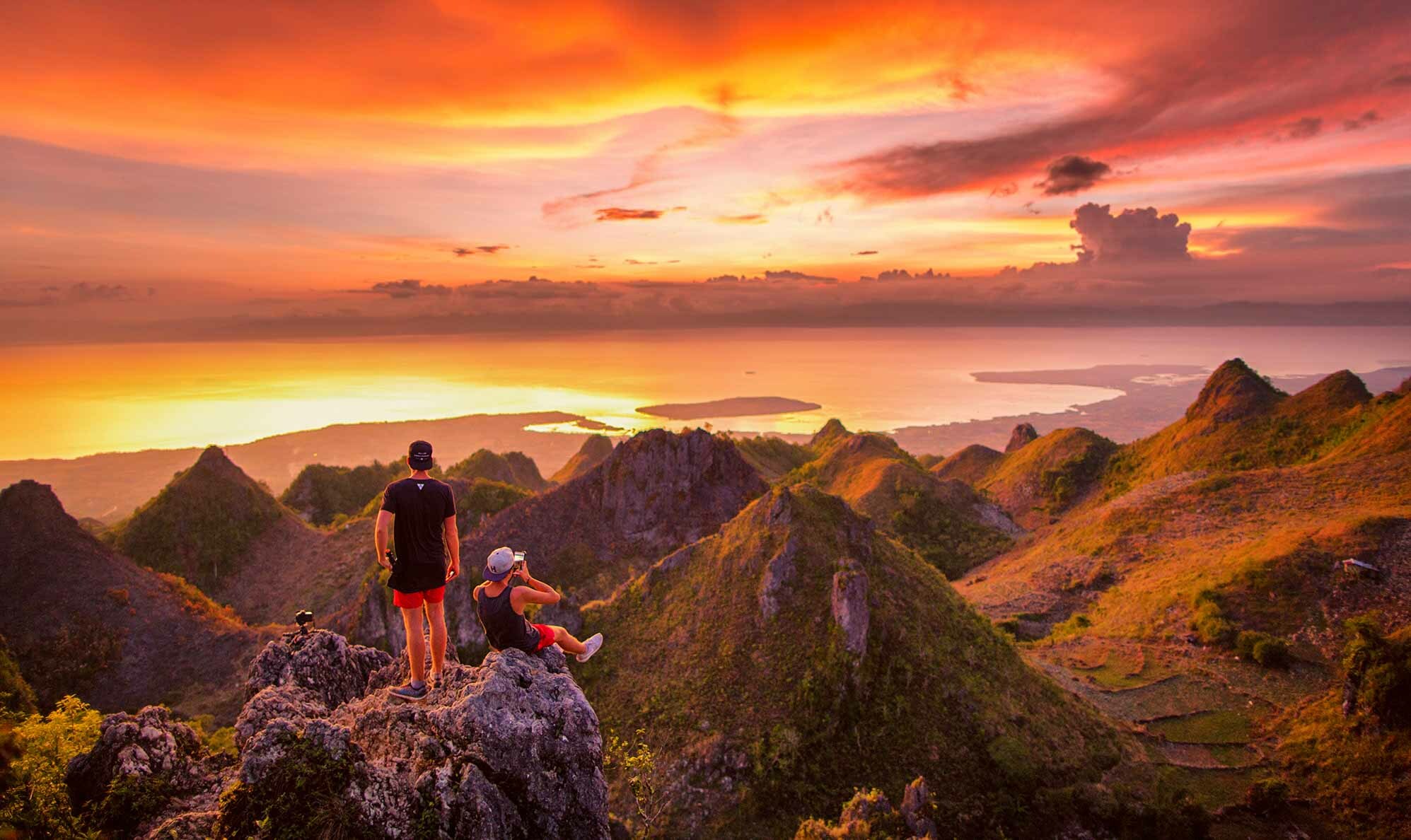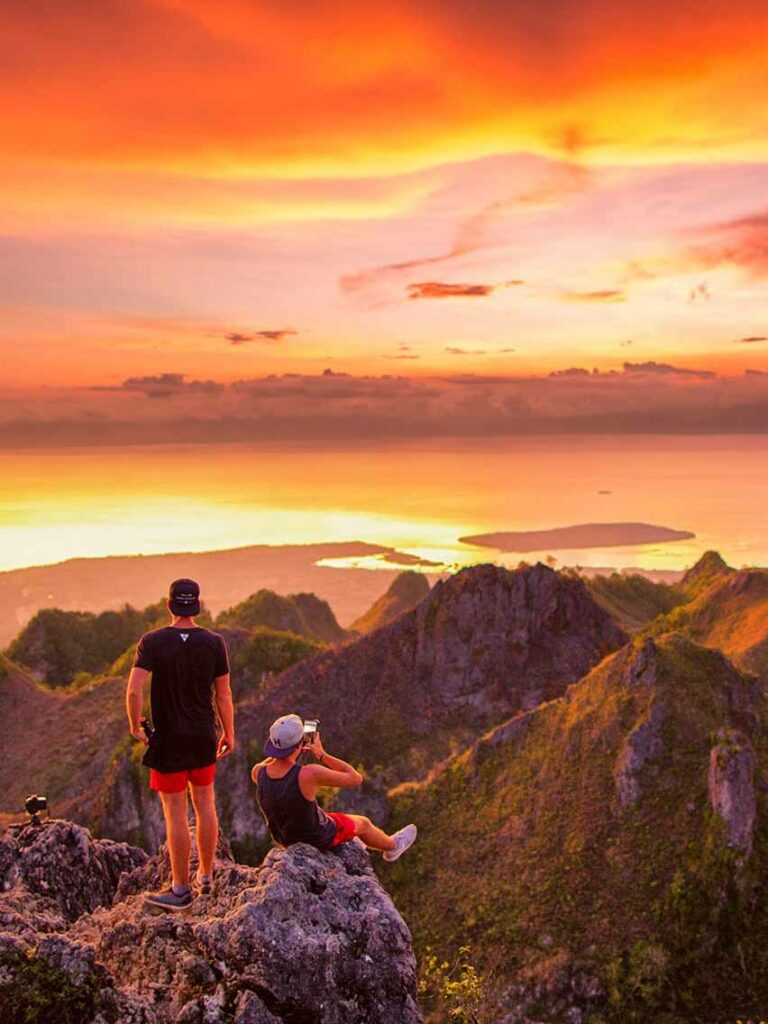
A Sustainable Sojourn
With its sights set on becoming a regional tourism powerhouse, the Philippines is welcoming travelers who aim to minimize their footprint
From the lush hills in Bohol to stunning islands and majestic marine life, the Philippines is home to breathtaking natural beauty, due in part to its location in the heart of the Coral Triangle, also known as ‘The Amazon of the Seas’. With the government’s plan to transform the country into a tourism powerhouse by 2028, the Philippines now aims to find a delicate balance between visitors’ enjoyment with environmental preservation to ensure a sustainable future for both tourism and the environment.

Diving and Eco-Adventures
The Philippines is uniquely located to offer countless eco-adventure experiences. The marine life of Cebu and Bohol, as well as the impressive cave system on Samar Island, are key spots for travelers looking to immerse themselves in nature but also leave no trace.
Malapascua Island in Cebu stands as the only place in the world where Thresher Sharks can be spotted year-round. Local diving companies set high sustainability standards, guaranteeing an environmentally conscious experience including ‘no touching’ policies that safeguard fragile coral reefs and marine life.
Just a short journey south, Bohol Province offers visitors the opportunity to dive with Barracudas, Dogtooth Tunas, and Giant Trevallies on Cabilao Island, as well as whale watching for a day above the water. Government restrictions on fishing practices protect local wildlife, while supporting boat tours provide an alternative livelihood to locals.
To the east on Samar Island, travelers can explore the second-largest cave system in Asia, the Langun-Gobingob Caves, comprising 12 interconnected caverns covering almost 3,000 hectares (30 sq km). Once threatened by mining, these caves were designated a protected area in 1997 to safeguard the endangered wildlife that live in the ancient cave complex. Visitors must adhere to eco-minded cave etiquette, ensuring the preservation of the caverns’ unique ecosystem.
Beaches and Islands
With 7,641 islands for travelers to discover, managing the impact that tourists can have on these areas is paramount for the government. Dumaguete, Palawan, and Mati all serve as excellent examples of the Philippines’ dedication to environmentalism.
Thanks to local marine conservation initiatives, Dumaguete, capital of the Province of Negros Oriental, stands out as a sustainable coastal destination where visitors can take a stroll down the beautiful Rizal Boulevard before visiting St Catherine Alexandria Cathedral, an 18th century stone church with an imposing bell tower once used to warn locals of raiding pirates. Dumaguete is also a gateway to explore the Province of Negros Oriental; from here, travelers can take a day trip to the nearby Apo Island, home to the Philippines’ first zero-waste village and a renowned marine sanctuary where visitors can swim with green and hawksbill turtles.

In 2018, the region of El Nido on Palawan Island took strict measures to protect its waters, including the jaw-dropping Big and Small Lagoons, with their limestone hills towering hundreds of feet above crystal clear waters. Inundated with eager visitors, the vibrant seabed was under threat from tourist boats but carrying capacities and controlled docking areas were instated, which now safeguard the Lagoons’ essential habitats.
In the very south of the Philippines, a surfer’s paradise awaits at Mati‘s Dahican Beach, a popular destination for those who love the waves. As well as visiting the 4.3-mile (7-km) sandy stretch that faces the Pacific Ocean, visitors will soon be able to visit The City of Mati Environmental and Eco-Tourism Center, a space will offer educational, scientific, and recreational tours to help efforts in the “preservation and conservation of mangrove forests and their biodiversity”.


Culture and Cuisine
Protecting local communities and their historical recipes is another key aspect of sustainability for Filipinos. The regions of South Cotabato are making shopping eco-friendly, while the foodie cultures of Ilocos and Pampanga put eco-agriculture at the center of every dish.
Visitors to South Cotabato should look to attend the T’nalak Festival, an annual event held in July to celebrate the indigenous T’boli tribe. The festival is a great opportunity for shopping lovers to support local traditions by purchasing locally woven, brightly colored T’nalak fabrics from Lake Sebu. Bargain hunters can also find unique vintage wares from one of the many Filipino thrift stores, known locally as ukay-ukays.
Meanwhile in the North, the agricultural hub of Ilocos embraces farm-to-table dining. Diners can indulge in local delicacies, such as Vigan Longganisa, a juicy garlic sausage, or Ilocano Pork Soup, and take comfort in knowing that the environmental impact is as minimal as the walk from the backyard to the dining table. In Vigan, a historic town awarded by UNESCO for its practices in sustainable conservationism and Management of World Heritage Properties, perfectly preserved colonial buildings and Spanish architecture offer a glimpse into another side of the region’s culture.
Through sustainable agriculture programs, Pampanga Province is equipping locals with the ability to create small-scale farming techniques and grow produce in their own backyards. Here, visitors can support local and try fare such as Sisig, a sizzling minced pork dish or the world-famous icy dessert Halo-Halo, and learn why Pampanga is on Conde Nast’s list of ‘Top 13 Unsung Food Destinations of the World’.
The Philippines is a remarkable example of a government committed to positive change. Through sustainable initiatives implemented at both local and national levels, tourism can coexist harmoniously with the environment. By preserving its awe-inspiring landscapes, vibrant marine ecosystems, and rich cultural heritage, the Philippines ensures that future generations can continue to experience the country’s abundant beauty while fostering a sustainable and responsible approach to travel.
All images courtesy of Tourism Promotions Board (TPB) Philippines










